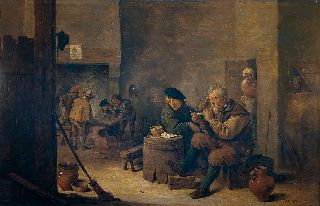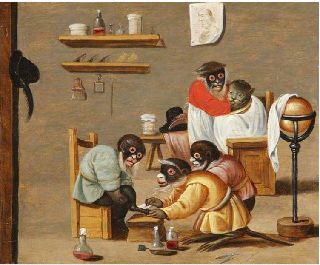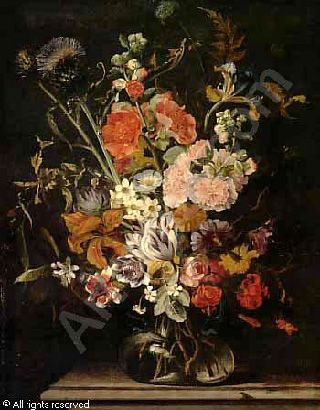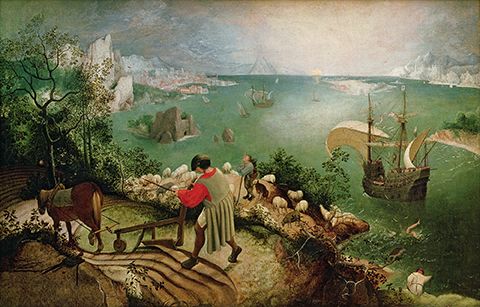The Last of the Brueghels
The purpose of the blog today is to complete the discussion of the Brueghel Dynasty of Artists. If you are reading my blog for the first time I suggest you read the previous two blog entries before this one so that you understand the background to the topic and you don't become totally confused with all the Brueghels. Yesterday we finished up with Jan Brueghel the Elder. Two of Jan's sons were artists: Jan Brueghel the Younger represented here with The Farmyard.

And Ambrosius Brueghel who painted floral pieces like his father. I like this pair titled Paar Blumenstillleben in Nische. Obviously flowers and a still life but translation please somebody.

Jan and Ambrosius had two sisters. Anna Brueghel(1619-1656), who was also called Catherine, married the painter David Teniers 11 (1610-1690) and thus joined two famous painter families and ensured the continuation of the artistic DNA. I rather like this one of David's paintings titled The Smokers.

In fact, David seemed to be quite obsessed with smoking. The painting below is titled is Monkey Trick.

Anna and David Teniers'son David Teniers 111 also became an artist and if you're thinking how important was environment in all of this look at the painting done by David of his wife Anna and their son David (111). I'm just surprised that he didn't become a famous musician as well. I believe more of their sons also became artists but I'm getting dizzy trying to follow them all. I just wish we could find one girl (apart from Mayken Verhulst generations earlier).

Unfortunately I haven't found any examples of the works of David Teniers 111.
The other daughter of Jan Brueghel the Elder, Paschasia Brueghel also produced two sons who were artists: Jan van Kessel the Younger(1654-1708) who went to live in Spain and painted still life of fruit with a monkey and a dog!

And Ferdinand van Kessel (1648-1696) who painted Monkey Barbers. I don't know what appeal the monkeys had but I will do some research. Of course they were popular as pets up until the 1900s. In fact when I was growing up in Bendigo in the 1950s there was a family nearby who had a cage of pet monkeys! Most likely illegal.

I'm sure you are getting sick and tired of the Brueghels and I haven't finished. Jan Brueghel the Younger also had sons who were artists. There was Jan Pieter Brueghel who kept up the floral theme.

Abraham Brueghel also liked painting flowers but added in a landscape, in the same painting!!

And Jan Baptist Brueghel (1647-1719) who was also a flower and still life painter. This is Still life with fruits, oysters and lobster on a table.

What have we learnt? The Brueghel Dynasty spanned nearly 200 years of influence from the early 1500s and thus created the Brand Brueghel. A curious fact is that Pieter Bruegel the Elder died at 45 years and apparently produced exactly 45 (known) paintings. To conclude I want to tell you a couple of interesting facts about Pieter Bruegel the Elder’s painting Landscape with the Fall of Icarus.

W.H. Auden's poem Musée des Beaux Arts (written in 1938) includes a reference to this painting:
In Breughel's Icarus, for instance: how everything turns away
Quite leisurely from the disaster; the ploughman may
Have heard the splash, the forsaken cry,
But for him it was not an important failure;
If you look carefully you can just see the legs of Icarus disappearing into the water in the bottom right hand corner. The farmer, ploughing, has far more important issues on his mind than someone falling out of the sky!
The poet William Carlos Williams (1883-1963) also wrote a poem titled Landscape with the Fall of Icarus about the same Bruegel painting. Williams' poem and the painting appear side-by-side 22 minutes into the 1976 film The Man Who Fell to Earth which starred David Bowie. I have seen this movie at the local Drive-In Theatre would you believe when I was quite young. Strangely I don't remember seeing the Bruegel painting!!
And so ends my tale about the Brueghels. However, I can't resist having a Brueghel Quiz. Coming up some time soon! And yes, there will definitely be a question on Mayken Verhulst.
Credits
1. commons.wikimedia.org
2. artnet.com
3. fineartamerica.com
4. alamy.com
5. pinterest.com
6. dorotheum.com
